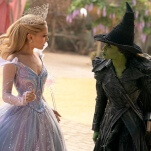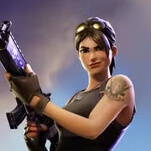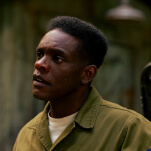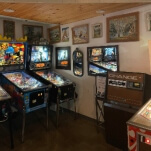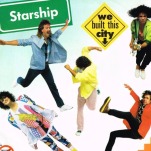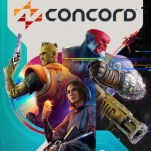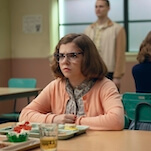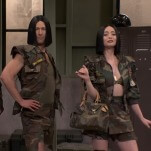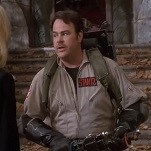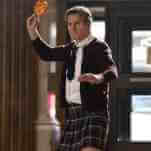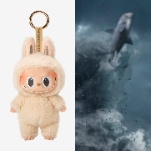It is difficult to come up with fresh praise for Jillian Tamaki’s SuperMutant Magic Academy (Drawn & Quarterly). It is one of those widely acclaimed and reviewed works that makes you question what gushing praise or astute observation there is left to bestow upon it that hasn’t already been noted. Originally serialized online between 2010 and 2014, and set in a generic magic/mutant boarding academy (one that you don’t really see much of, and serves largely as a winking background), this complete print collection is so good and so perfectly pitched in its witty, wry observations as Tamaki simultaneously captures and demolishes narrative assumptions around her young cast.
What makes SuperMutant Magic Academy so roundly relatable is that as much as those doubts and fears and hopes and general overwrought-ness are attributed to the teenage years, it’s not clear how much of that changes as life goes on. When you’re younger, absolutely everything feels big and important and impactful (or to the other extreme—nothing matters, at all, ever) and terrifying because of it, and the guileless awfulness of watching these young people rush and claw to already be the way they think they should or want to be is almost as melancholic as it is amusing. It’s hard not to see people reading through this and grinning in recognition and mirth, with much shaking of the head: that used to be you, that still is you in parts, you still know people like that.
Equally there’s also the feeling it’s not really that serious: the “myth” of the teen years—built up or torn down to either extremity—is what it is. Tamaki’s characterization is robust enough to retain a sense of individuality even while embodying those broad strokes. The voices and dialogue read so naturally that it firmly places you with these people and their situations: Frances, with her weary takedowns of art culture, performing with an unparalleled degree of earnest cynicism; Marsha’s quiet, obvious love and frustration for and at Wendy, whose personhood gets forgotten among her popular-girl niceness; Gemma’s constant searching for self and envy at seeing others seemingly sorted; Cheddars, who could if he tried but doesn’t really want to, because what does it all matter anyway; and Everlasting Boy, maybe knowing everything, maybe knowing nothing—immortality doesn’t seem to have made much of a difference. In turns nonchalant and harried, the trundle of minutiae rolls ever on.
That same do-care/don’t-care attitude is reflected in Tamaki’s brushstrokes that at times feel very immediate—thick and quick—and then more considered. It’s a little thing, but the way she uses blacks to personify hair is lovely: the messy fat scribble for Frances’ curls, Wendy’s glossy mane, Marsha’s neat page-boy, the outrageous outline of Gemma’s beehive, Cheddar’s cool bedhead tufts.
It’s a much more cohesive and satisfying read as a whole book than the periodic single strips, allowing characters and ongoing threads to interlock and bounce off of each other to greater, undiluted effect. But the real magic of SuperMutant Magic Academy is just how good it is: smart and caustic, yes, but reassuring and reflective too. And above all: very, very bloody funny. [Zainab Akhtar]
For all that the largest comic book publishers in the U.S. have been embracing increased diversity and more nuanced stories, there are still huge gaps—subjects that aren’t getting printed. It’s not entirely unheard of for even the cape-and-cowl crowd to get a chance to deal with complicated current events; 2001’s
Amazing Spider-Man #36 proves that much. But for those that were waiting for mainstream comics to confront the impossible-to-ignorable racial politics that that gained widespread visibility in August last year,
Material #1 (Image) is one of the first. Writer Ales Kot is not known for shying away from difficult topics and complicated ideas. Even when he’s working for the more risk-averse Marvel, Kot’s got a style that embraces uncertainty and unanswered questions. Like his previous work,
Material is a slow burn. The story comes together gradually, and there are still gaps that likely won’t be filled for some time to come.
This issue leads off with a college lecture that includes musing on hyper-capitalism and digital dualism, topics that are no stranger to people who follow him on social media but are a far cry from what you see in most comic books. The rest of the book unfolds in a series of double-page spreads that bounce from one story to the next. After the MIT professor is a story of a burnt-out actress and an up-and-coming director, followed by a young black protester, and finally a former Guantanamo detainee. This is not a lighthearted book. Nearly every page has a footnote with suggested further reading; it’s worth taking the time to at least look at them and even going to read a few on your own. Much like in Bitch Planet, the back two pages of the issue are dedicated space for an essay which is also well worth taking some time to read. This is not a book to passively consume; it requires some thought and effort to process, but that’s a large part of the draw.
Kot and artist Will Tempest previously worked together on Zero, and their established working relationship serves them well here. In fact, the entire Zero team has reunited here, with Clayton Cowles on letters and design by Tom Muller. A less experienced group might not be able to pull off a book as complicated and heavy as this one. The art is deceptively simple—some panels are very dialogue-heavy while others exist without words at all. Tempest deftly uses color to differentiate between the four core plots as Kot flips from one to the next. The stark, rigid panels help the story move quickly. Many of them are tight and narrow, nine to a page, and feel intimate if not claustrophobic. When they do open up, it’s like being able to take a deep breath again, finding a moment’s rest before diving back in.
This book isn’t for everyone, though maybe it should be. Even just one issue in it’s forcing the audience to confront uncomfortable truths behind headline-grabbing violence, not to mention the aftershocks that so often get ignored once the cameras and journalists have left. [Caitlin Rosberg]
The gekiga that emerged in Japan in the late 1950s came to prominence by positioning itself as a conscious departure from the more commercial manga being produced at the time by mainstream practitioners such as Osamu Tezuka. Early gekiga was concerned with urban malaise and anomie in the postwar period, presenting a rough vision of life during the supposed boom times of the middle Shōwa period. The demise of the rental comics market in the mid-1960s led to a downturn in gekiga production. Some of the genre’s most famous names, such as Yoshiharu Tsuge, had moved onward from the strict realism of gekiga into the realm of surrealism, a shift typified by the rising popularity of the avant-garde magazine
Garo.
The work of Yoshiharu Tsuge’s brother, Tadao, makes an overdue entry to North America with the volume Trash Market (Drawn & Quarterly). It’s common to refer to Yoshiharu as the Robert Crumb of Japan—one of, if not the most prominent underground cartoonist of the era, and an influence to many successive generations of alternative mangaka. Amazingly, a full volume of Yoshiharu’s work has never been produced for the English-language market. But Tadao’s work has arrived, lovingly translated by manga scholar Ryan Holmberg. Tsuge’s stories in the present volume, taken from a four-year period from 1968 to 72, postdate the heyday of gekiga, but share more in common with the prime 1950s work of Yoshihiro Tatsumi than his brother’s own contemporaneous work in Garo.
Postwar Japan, as illustrated by Tadao, is an ugly place. Tsuge the younger worked for 10 years in a neighborhood blood bank, cleaning instruments and disposing of spoiled blood. Based on Tsuge’s own recollections, this was dismal, dark work that exposed him to the worst elements of Tokyo’s “human trash” (his colorful phrase). But this same trash inspired his most empathetic and engaging work. The volume’s title story is a series of brief sketches detailing the lives of a group of homeless or underemployed men and women who congregate around the local blood bank in hopes of selling enough to be able to afford to eat. They’re all-around lowlifes, but the irony of their plight—selling pieces of themselves in order to be make enough to be able to survive until they’re ready to sell another piece of themselves—is enough to humanize them, even as they sweat away their desultory days in the heat of the summer.
Tsuge’s stories often imply larger contexts, while still maintaining a strict focus on the material realities of life in the economic underworld. One story touches—briefly—on Japanese anxiety over increasing American military presence on the island during the Vietnam War. Others reflect on the growing restlessness of older generations of lower-middle-class salary men, combat veterans with PTSD and content simply to fall through the cracks of an increasingly partitioned society. Tsuge’s art is sketchy and lyrical, barely drawn in some places and densely illustrated in others. If his brother is Crumb, than Tadao stands somewhere between Spain Rodriguez and Harvey Pekar—doggedly committed to a view of comics realism that is both unflattering and unflinching. [Tim O’Neil]
Airboy #1 (Image) begins with writer James Robinson sitting on a toilet, struggling to have a bowel movement while chatting with Image Comics publisher Eric Stephenson about reimagining the titular Golden Age superhero. It’s a visual that immediately establishes a sense of vulnerability for the creator, but it’s also representative of Robinson’s status in life at this moment in time. He’s completely blocked up creatively, knows his work at DC Comics is shit, and doesn’t have any inspiration for the project Stephenson has pitched him.
The question of how Robinson gets from the first page to the point where he’s writing that first page is the major appeal of this new autobiographical ongoing series, which has Robinson detailing all his flaws for the world to see. His alcoholism is ruining his marriage, and the only way Robinson can kick-start his imagination is with a steady flow of drugs that include cocaine, ecstasy, and, in a first for Robinson, heroin. He hasn’t made a connection between the deteriorating state of his life and his substance abuse, but the last page of this issue suggests that he’ll get help from an unlikely source: Airboy himself, who visits Robinson and artist Greg Hinkle after a chaotic night on the town.
With this new project, Robinson taps into the font of self-loathing that defines a lot of alt-comics work but doesn’t get much play in the mainstream. Robinson despises the person he is in these pages, and this first issue gives the impression that this series is a way for Robinson to exorcise his demons by revealing them to the public. This is a very personal story for Robinson, and that strong connection inspires some of his strongest writing in years. The script for Airboy is brutally honest, and that eagerness to expose everything carries over into the artwork. Robinson and Hinkle’s genitalia are featured prominently in one scene, but the nudity is far from gratuitous. It’s all part of the book’s overarching theme of vulnerability, and showing these men completely stripped down after an exhausting night of hard drug use highlights their morning-after shame.
Robinson describes why he wanted Hinkle as his collaborator in the pages of this issue, stating that Hinkle has a strong artistic style that will draw more attention to an Airboy revamp. He’s completely right, and Hinkle’s expressive, detailed linework and bold coloring give the book a distinct look that elevates the script. Hinkle’s artwork is very subdued for most of the issue, which helps ground the story, but for the scene of the two men at the start of their bender, Hinkle whips out an inventive two-page spread that toys with panel composition to show the creators’ increasing intoxication. The final page suggests that Hinkle is going to have even more opportunities to play around as Airboy enters the narrative, and the arrival of the Golden Age hero opens up storytelling possibilities that build a lot of anticipation for the next chapter of this introspective, hard-hitting series. [Oliver Sava]
